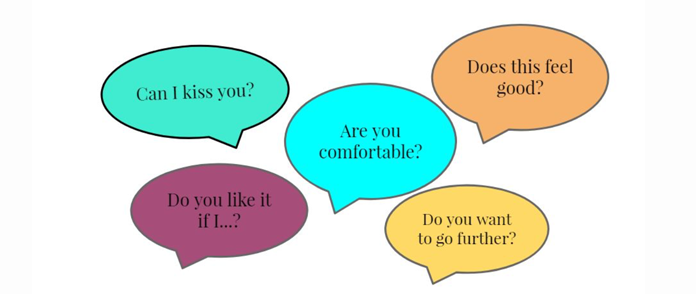CARE is open and offering confidential support for students, faculty, and staff.
To schedule an appointment with an advocate, please click the button below.
Informed.
Consent is an unambiguous, affirmative and conscious decision by each person to engage in mutually agreed-upon sexual activity.
Voluntary.
Consent is willing, positive cooperation in an act or the expression of a desire to engage in an activity. True consent isn't coerced by force, threats or intimidation. Silence is not consent.
Revocable.
Consent on one occasion doesn't mean consent has been given for future sexual activity. Consent can be given and withdrawn at any point, regardless of the nature of the relationship. Once consent is withdrawn, any activity must stop immediately.
Verbal Consent
Consent can be verbal. This is the clearest and safest form of consent. Examples of giving verbal consent include:
- “Yes”
- “That sounds great”
- “That feels awesome”
- “Let’s do that more”
- “I’d like to . . .”
- “It feels good when you . . .”
- “Would you please . . .”
- “I want to keep doing this”
- “I’m enjoying this”
Non-Verbal Consent
Consent can also be non-verbal. There are ways to express a clear willingness to engage in sexual contact without using words. Examples of giving nonverbal consent may include:
- Head nod
- Thumbs up
- Pulling someone closer
- Nodding yes
- Making direct eye contact
- Actively touching someone
- Initiating sexual activity
However, it is important to remember that body language is different for everyone, and relying on it alone can sometimes be problematic. If you’re not sure that you’re getting a clear, enthusiastic yes from your partner, it is your responsibility to ask. You cannot assume that you have consent because someone is not physically resisting or verbally refusing sexual contact. Consent is not to be inferred from silence, passivity, or a lack of resistance.
Examples of Situations Where There is No Consent
Here are some examples of verbal non-consent:
- “No”
- “Stop”
- “I don’t want to”
Remember, the absence of a verbal “no” is not the same as a “yes”. Body language can also be used to communicate a lack of consent. Here are some non-verbal signals that you need to stop and check in with your partner:
- Silent/saying nothing
- Turning their head or body away from you
- Pushing you away
- Lying still, not participating
- Avoiding touch/not touching you
Other Situations Where There is No Consent
It’s also important to remember that getting consent for one type of sexual contact doesn’t mean you have consent for other kinds. If someone is pulling you closer and they are enthusiastic about making out, it doesn’t mean that they’ve consented to activity beyond making out.
Consent also cannot be obtained by coercion or force or by taking advantage of someone who is incapacitated. Using threats or manipulation to get someone to say yes isn’t consent. Consent must be freely given, which means that a person is choosing to say yes when they are also free to say no. If someone feels like they have to say yes because saying no would result in harm or negative consequences, that’s not freely given consent.
Consent can be withdrawn at any time. Once consent is withdrawn, the sexual contact must cease immediately.
How to Ask for Consent
Here are some examples of how to ask for consent:
- “I really want this to be good for you… What do you like?”
- “Does ______(activity) feel good to you?”
- “I’d really like to _____(activity) – Would you be into that?”
- “May I . . .?”
- “I’d like to . . . would you like to? If not, what would you like to do?”
- “How do you feel about doing . . . ?”
- “What do you need to feel comfortable or safe when we . . . ?”
- “I’m really interested in doing . . . with you. Do you want to do that?”
- “I’d like to have sex tonight, would you?”
- “What do you want to do or try tonight?”
There are many ways to ask for and give consent. There are also many ways to indicate that someone’s NOT consenting to sexual contact.
Adapted from Safe at UNC


